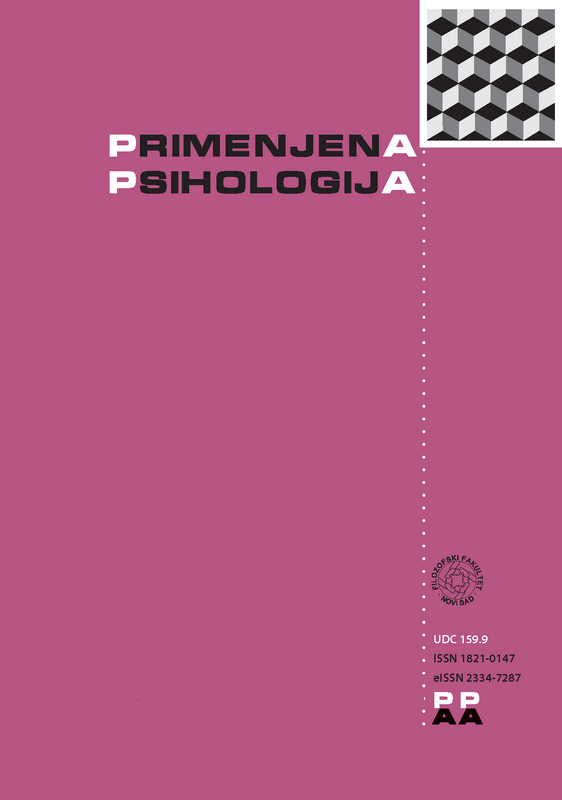EQUITY OF PROFILES BETWEEN COMPUTER-BASED AND CLASSICAL MODALITY OF MMPI-202
DOI:
https://doi.org/10.19090/pp.2015.3.311-333Keywords:
MMPI-202, computer-based testing, equity of measurement, experiential equivalence, profiles similarityAbstract
With the increasing application of computer-based tests, a problem of equivalence between computerized and classical forms has appeared. Studies regarding equivalence of computerbased and paper and pencil forms of psychological tests usually examined the impact of individual differences and variables such as computer experience and computer anxiety. Previous research gave mixed results. The aim of this study was to determine whether there were differences in the profiles of subjects on computer-based and classical modality of the MMPI-202. In addition, the aim of this study was to examine the influence of gender, age, education level, computer experience, and computer anxiety on examinees’ profiles on the computer and the classical modality of this test. There were no significant differences in examinees’ profiles which could be attributed to the modality of testing.References
American Psychological Association (1986). Guidelines for computer-based tests and interpretations. Washington, DC: APA.
Barbeite, F. G., & Weiss, E. M. (2004). Computer self-efficacy and anxiety scales for an Internet sample: Testing measurement equivalence of existing measures and development of new scales. Computers in Human Behavior, 20, 1–15.
http://dx.doi.org/10.1016/S0747-5632(03)00049-9
Bartram, D., & Bayliss, R. (1984).Automated testing: Past, present and future. Journal of Occupational Psychology, 57, 221–237.
http://dx.doi.org/10.1111/j.2044-8325.1984.tb00164.x
Biro, M. (1995). Dijagnostička procena ličnosti – MMPI-202. Novi Sad: Futura publikacije i Filozofski fakultet.
British Psychological Society (1999). Guidelines for the development and use of computerbased assessments. Leicester: British Psychological Society.
Brosnan, M. J. (1998). The impact of psychological gender, gender-related perceptions, significant others, and the introducer of technology upon computer anxiety in students. Journal of Educational Computing Research, 18, 63–78.
http://dx.doi.org/10.2190/lvhh-epgb-ae7j-wev8
Bugbee, A. C. Jr. (1996). The equivalence of paper-and-pencil and computer-based testing. Journal of Research on Computing in Education, 28, 282–290.
http://dx.doi.org/10.1080/08886504.1996.10782166
Burke, M. J., & Normand, J. (1987). Computerized psychological testing: Overview and critique. Professional Psychology Research and Practice, 1, 42–51.
http://dx.doi.org/10.1037/0735-7028.18.1.42
Butcher, J. N., &Williams, C. L. (2009). Personality assessment with the MMPI-2: Historical roots, international adaptations, and current challenges. Applied Psychology: Health and Well-Being, 1, 105–135.
http://dx.doi.org/10.1111/j.1758-0854.2008.01007.x
Butcher, J., Derksen, J., Sloore, H., & Sirigati, S. (2002). Objective personality assessment of people in diverse cultures: European adaptations of the MMPI-1. Behaviour Research and Therapy, 41, 819–840.
http://dx.doi.org/10.1016/S0005-7967(02)00186-9
Chua, S. L., Chen, D., & Wong, A. F. L. (1999). Computer anxiety and its correlates: A meta-analysis. Computers in Human Behavior, 15, 609–623.
http://dx.doi.org/10.1016/S0747-5632(99)00039-4
Colley, A., Gale, M., & Harris, T. (1994).Effects of gender role identity and experience on computer attitude components. Journal of Educational Computing Research, 10, 129–137.
http://dx.doi.org/10.2190/8NA7-DAEY-GM8P-EUN5
Fajgelj, S. (2005). Psihometrija – Metod i teorija psihološkog merenja. Beograd: Centar za primenjenu psihologiju.
Finger, M. S., & Ones, D. S. (1999). Psychometric equivalence of the computer and booklet forms of the MMPI: A meta-analysis. Psychological Assessment, 11, 58–66.
http://dx.doi.org/10.1037/1040-3590.11.1.58
Groth-Marnat, G. (2003).Handbook of psychological assessment. New York: John Willey & Sons.
Heinssen, R. K. Jr., Glass, C. R., & Knight L. A. (1987). Assessing computer anxiety: Development and validation of the Computer Anxiety Rating Scale. Computers in Human Behavior, 3, 49–59.
http://dx.doi.org/10.1016/0747-5632(87)90010-0
Honaker, L. (1988). The equivalency of computerized and conventional MMPI administration: A critical review. Clinical Psychology Review, 8, 561–577.
http://dx.doi.org/10.1016/0272-7358(88)90081-5
Honaker, L. M., Harrell, T. H., & Buffaloe, J. D. (1988). Equivalency of Microtest computer MMPI administration for standard and special scales. Computers in Human Behavior, 4, 323–337.
http://dx.doi.org/10.1016/0747-5632(88)90004-0
International Test Commission (2005). International guidelines on computer- based and Internet delivered testing. Retrieved from http://www.intestcom. org/upload/sitefiles/62.pdf
Janičić, B. (2004). Konstrukcija i evaluacija ekspertskog sistema za interpretaciju MMPI (Neobjavljena magistarska teza). Filozofski fakultet, Novi Sad.
Jennrich, R. I. (1970). An asymptotic χ2test for the equality of two correlation matrices. Journal of American Statistical Association, 65, 904–912.
http://dx.doi.org/10.1080/01621459.1970.10481133
Johnson, D., & White, C. (1980). Effects of training on computerized test performance in the elderly. Journal of Applied Psychology, 65, 357–358.
http://dx.doi.org/10.1037/0021-9010.65.3.357
King, W. C., & Miles, E. W. (1995). A quasi-experimental assessment of the effect of computerizing noncognitive paper-and-pencil measurements: A test of measurement equivalence. Journal of Applied Psychology, 80, 643–651.
http://dx.doi.org/10.1037/0021-9010.80.6.643







